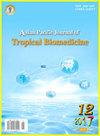棒氏Terfezia甲醇提取物对几种常见感染性腹泻病原菌的抗菌和抗寄生虫活性
IF 1.7
4区 医学
Q3 TROPICAL MEDICINE
引用次数: 0
摘要
目的:评价棒氏Terfezia甲醇提取物对大肠杆菌、鼠伤寒沙门氏菌、福氏志贺菌和蓝氏贾第鞭毛虫的止泻作用。方法:采用微量肉汤稀释法测定棒叶Terfezia甲醇提取物的最低抑菌浓度(MIC)和最低杀菌浓度。此外,还评估了活性氧的产生和蛋白质泄漏。为了评估棒氏Terfezia甲醇提取物的体外抗贾第虫作用,用不同浓度的棒氏Terfezia甲醇提取液处理蓝氏贾第虫WB(ATCC®30957)滋养体10-360分钟。此外,还测定了棒氏Terferzia甲醇提取物处理的滋养体的质膜通透性。还使用MTT法评估了棒毛Terfezia甲醇提取物对正常细胞(HEK293T)和癌症细胞(MCF-7)的细胞毒性作用。结果:棒叶Terfezia甲醇提取物对细菌的MIC和最低杀菌浓度分别为0.52-1.04和1.04-2.08mg/mL。结果表明,棒氏Terfezia甲醇提取物处理后,细菌的活性氧生成和蛋白质渗漏显著增加,特别是在1/3和1/2 MICs时(P<0.001)。此外,棒氏Terfezia甲烷提取物以剂量依赖的方式降低了蓝氏贾第虫滋养体的活力。棒氏Terfezia甲醇提取物浓度分别为1、2和4 mg/mL,在360、240和120分钟后,蓝氏贾第鞭毛虫滋养体的死亡率分别为100%。此外,棒叶Terfezia甲醇提取物通过增加浓度改变了兰氏贾第鞭毛虫滋养体质膜的通透性。MTT分析显示,HEK293T和MCF-7细胞50%的细胞毒性浓度值分别为4.32 mg/mL和6.40 mg/mL,表明克拉氏Terfezia甲醇提取物对癌症细胞的细胞毒性比正常细胞大。结论:棒氏Terfezia甲醇提取物对大肠杆菌、鼠伤寒沙门氏菌、福氏志贺菌和蓝氏贾第鞭毛虫具有较强的体外抗菌和抗寄生作用,通过影响细胞膜通透性和活性氧的产生,对正常细胞无明显的细胞毒性。本文章由计算机程序翻译,如有差异,请以英文原文为准。
Antibacterial and anti-parasitic activities of Terfezia claveryi methanolic extract against some common pathogenic agents of infectious diarrhea
Objective: To assess the antidiarrheal effects of Terfezia claveryi methanolic extract against Escherichia coli, Salmonella typhimurium, Shigella flexneri, and Giardia lamblia. Methods: Antibacterial effects of the Terfezia claveryi methanolic extract were carried out by determining the minimum inhibitory concentration (MIC) and minimum bactericidal concentration through micro broth dilution technique. Furthermore, reactive oxygen species production and protein leakage were evaluated. To evaluate the in vitro anti-giardial effects of Terfezia claveryi methanolic extract, Giardia lamblia WB (ATCC® 30957) trophozoites were treated with various concentrations of Terfezia claveryi methanolic extract for 10-360 min. In addition, the plasma membrane permeability of trophozoites treated with Terfezia claveryi methanolic extract was determined. The cytotoxicity effects of Terfezia claveryi methanolic extract against normal (HEK293T) and cancer (MCF-7) cells were also assessed using the MTT assay. Results: The MIC and minimum bactericidal concentration of Terfezia claveryi methanolic extract against bacterial strains were in the range of 0.52-1.04 and 1.04-2.08 mg/mL, respectively. The results revealed that reactive oxygen species production and protein leakage were significantly increased after the bacteria were treated with the Terfezia claveryi methanolic extract, especially at 1/3 and 1/2 MICs (P<0.001). Furthermore, Terfezia claveryi methanolic extract decreased the viability of Giardia lamblia trophozoites in a dose-dependent manner. Terfezia claveryi methanolic extract at 1, 2, and 4 mg/mL resulted in 100% mortality in Giardia lamblia trophozoites after 360, 240, and 120 min, respectively. Moreover, Terfezia claveryi methanolic extract altered the permeability of plasma membrane of Giardia lamblia trophozoites by increasing the concentration. MTT assay revealed that the 50% cytotoxic concentrations values for HEK293T and MCF-7 cells were 4.32 mg/mL and 6.40 mg/mL, respectively, indicating that Terfezia claveryi methanolic extract had greater cytotoxicity against cancer cells than normal cells. Conclusions: Terfezia claveryi methanolic extract had potent in vitro antibacterial and anti-parasitic effects on Escherichia coli, Salmonella typhimurium, Shigella flexneri, and Giardia lamblia by affecting cell membrane permeability and reactive oxygen species generation with no significant cytotoxicity on normal cells.
求助全文
通过发布文献求助,成功后即可免费获取论文全文。
去求助
来源期刊

Asian Pacific journal of tropical biomedicine
Biochemistry, Genetics and Molecular Biology-Biochemistry, Genetics and Molecular Biology (miscellaneous)
CiteScore
3.10
自引率
11.80%
发文量
2056
审稿时长
4 weeks
期刊介绍:
The journal will cover technical and clinical studies related to health, ethical and social issues in field of biology, bacteriology, biochemistry, biotechnology, cell biology, environmental biology, microbiology, medical microbiology, pharmacology, physiology, pathology, immunology, virology, toxicology, epidemiology, vaccinology, hematology, histopathology, cytology, genetics and tropical agriculture. Articles with clinical interest and implications will be given preference.
 求助内容:
求助内容: 应助结果提醒方式:
应助结果提醒方式:


